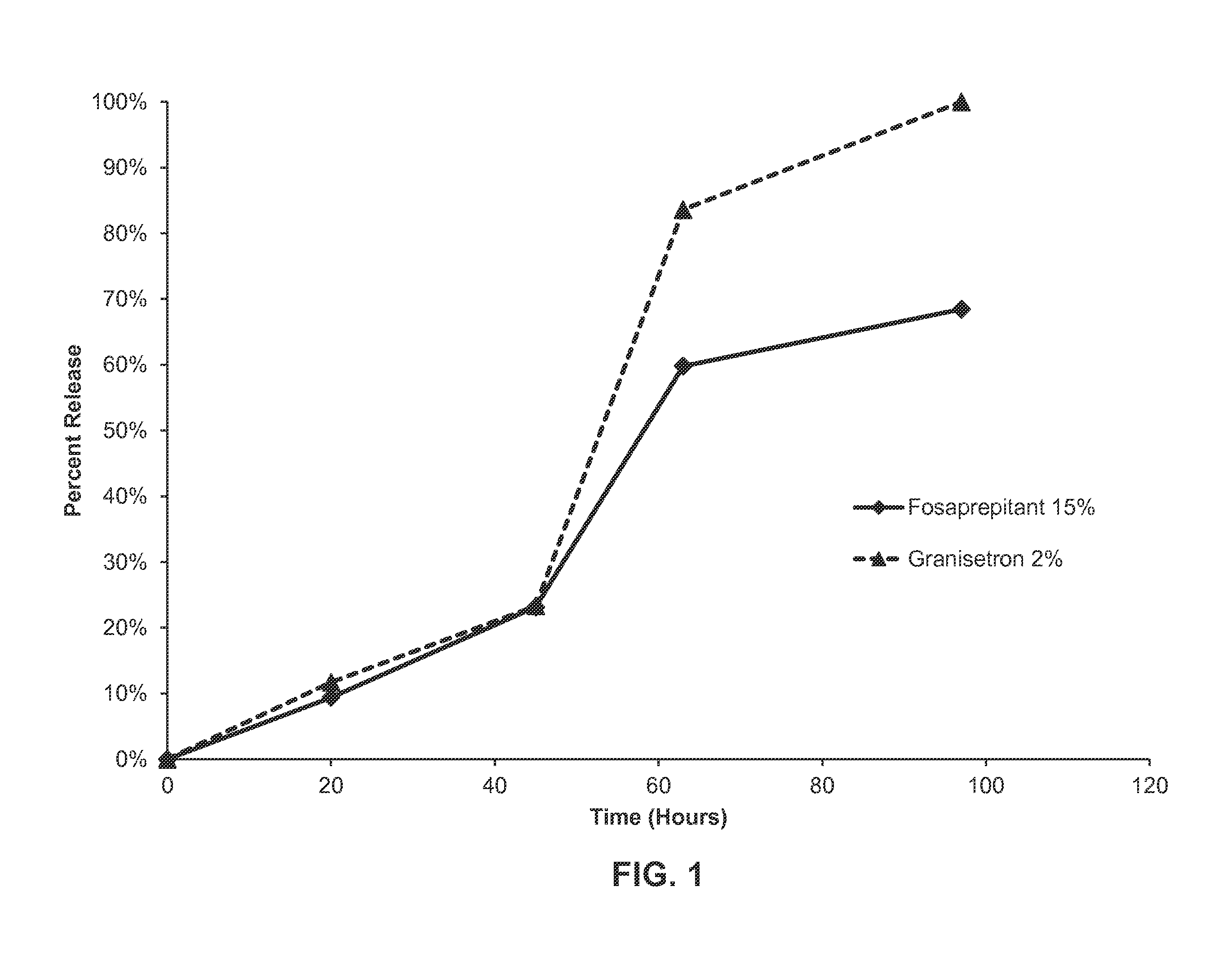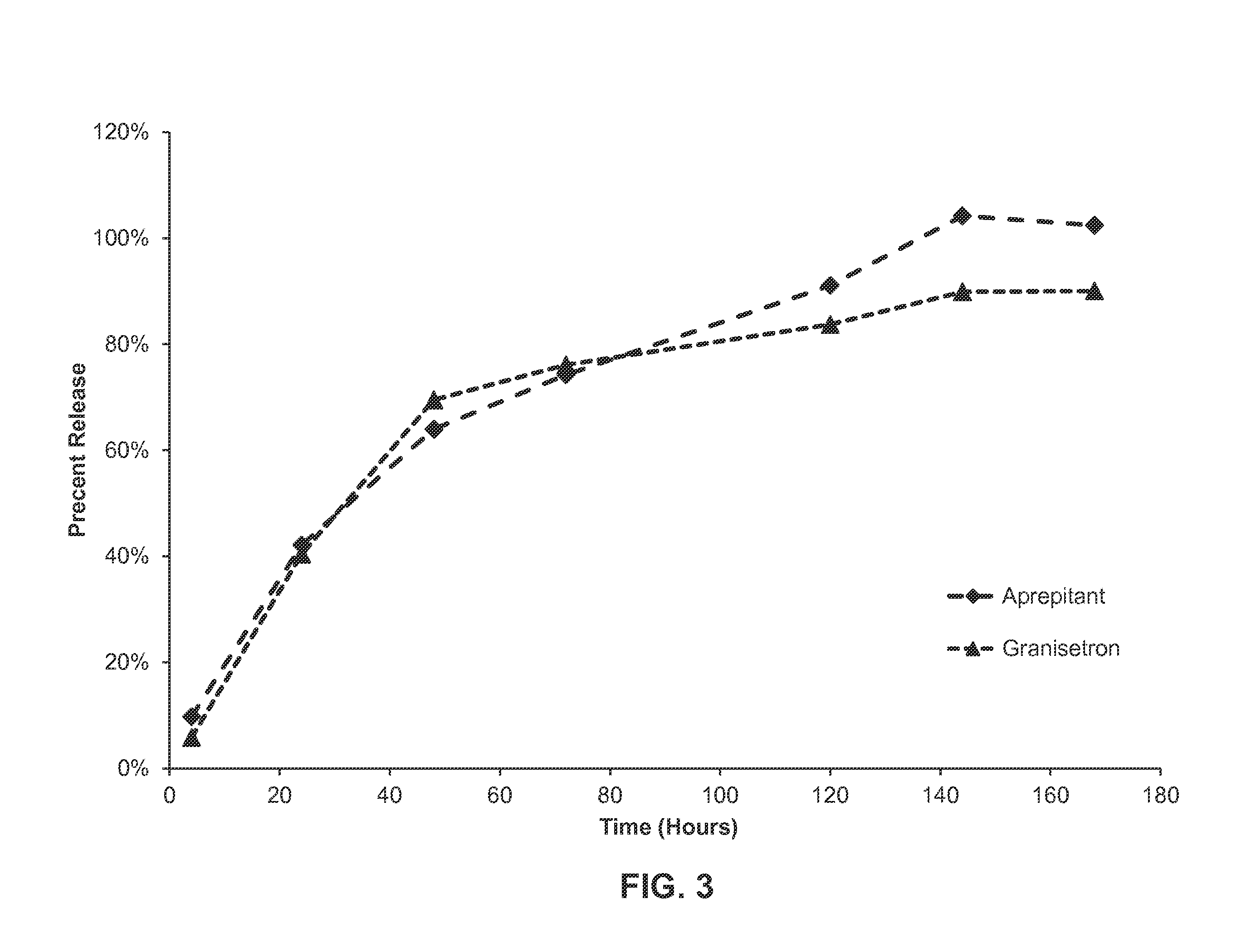Pharmaceutical composition comprising antiemetic compounds and polyorthoester
a technology of antiemetic compounds and polyorthoester, which is applied in the field of pharmaceutical compositions, can solve the problems of severe and distressing side effects, affecting patient function and activity, nausea and vomiting, etc., and achieves the effect of prolonging the antiemetic activity and minimizing the side effects of nausea and/or emesis
- Summary
- Abstract
- Description
- Claims
- Application Information
AI Technical Summary
Benefits of technology
Problems solved by technology
Method used
Image
Examples
example 1
Preparation of a Semisolid Formulation Containing Aprepitant and Granisetron
[0154]375 mg of aprepitant was dissolved in 1.3 g of a polyorthoester-compatible liquid excipient, dimethyl sulfoxide, and heated until completely dissolved. 100 mg of granisetron was added to the mixture and heated until the granisetron and the aprepitant were completely dissolved. The polyorthoester (having a molar ratio of DETOSU:TEG:TEG-diGL of about 90:80:20) was brought to approximately 80° C. and mixed into the solution comprising the granisetron and aprepitant until completely homogenous to provide a semi-solid formulation comprising the illustrative 5-HT3 receptor antagonist and NK-1 receptor antagonist, granisetron and aprepitant, respectively.
example 2
In-Vitro Release of Formulation of Aprepitant and Granisetron
[0155]A formulation as described in Example 1 was weighed into vials and filled with a phosphate buffered saline solution and 2% CTAB (cetrimonium bromide). The vials were then stored at 37° C. Aliquots were taken daily and analyzed by HPLC to monitor for the release of granisetron and aprepitant from the formulation. See FIG. 3. As shown in FIG. 3, in vitro release of each of the active agents proceeded in a linear fashion up to about 48 hours, with about 65% of each active agent released over this time period. After about 120 hours, about 90% of the aprepipant was released from the formulation, while about 80% of granisetron had been released over the same time frame. Essentially all of the aprepitant is released from the formulation at about 144 hours, while about 90% of the granisetron is released over the same duration.
[0156]This data demonstrates that both active agents are released in a sustained fashion over time f...
example 3
Preparation of a Semi-solid Formulation Containing Aprepitant
[0157]750 mg of aprepitant was dissolved in 2.3 g of a polyorthoester-compatible liquid excipient, dimethyl sulfoxide, and heated until completely dissolved. The polyorthoester described in Example 1 (80:20 TEG-TEG diglycolide diol molar ratio) was brought to approximately 80° C. and mixed into the solution comprised of aprepitant until completely homogenous.
PUM
| Property | Measurement | Unit |
|---|---|---|
| Percent by mass | aaaaa | aaaaa |
| Percent by mass | aaaaa | aaaaa |
Abstract
Description
Claims
Application Information
 Login to View More
Login to View More - R&D
- Intellectual Property
- Life Sciences
- Materials
- Tech Scout
- Unparalleled Data Quality
- Higher Quality Content
- 60% Fewer Hallucinations
Browse by: Latest US Patents, China's latest patents, Technical Efficacy Thesaurus, Application Domain, Technology Topic, Popular Technical Reports.
© 2025 PatSnap. All rights reserved.Legal|Privacy policy|Modern Slavery Act Transparency Statement|Sitemap|About US| Contact US: help@patsnap.com



